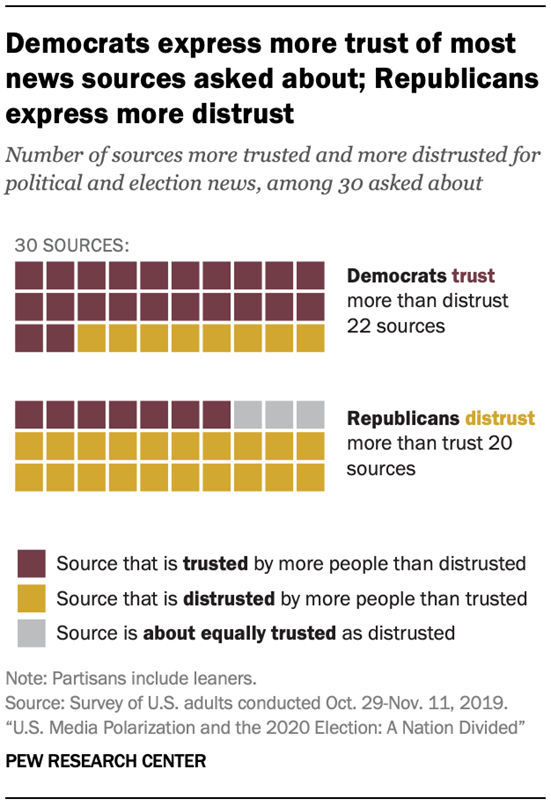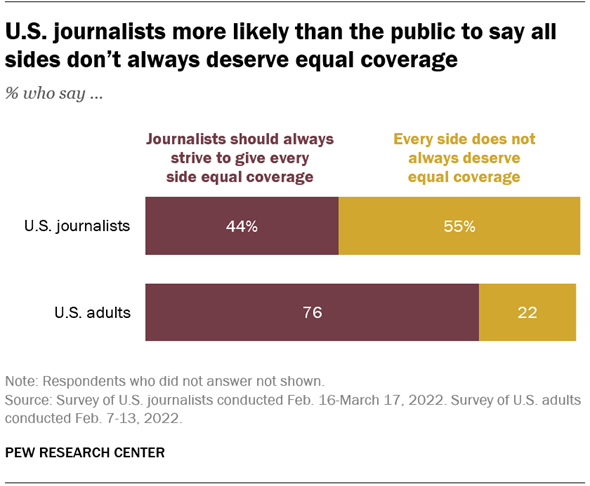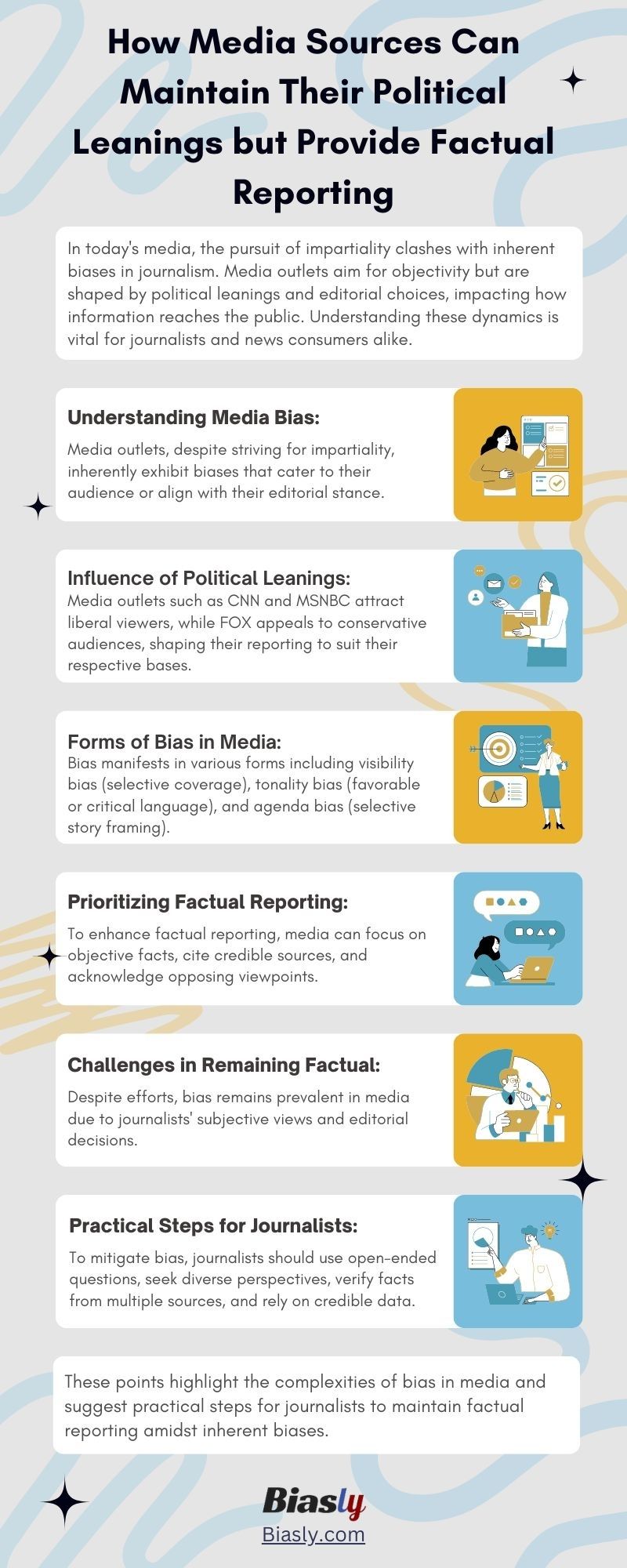
While we, as a society, like to think of the media as an impartial source of truth and fact, the reality is nearly every institution has its biases, and the media is no different. While some news sources try and take measures to overcome these biases, others lean into them to better appeal to their fanbase, but no matter their approach to managing bias, every media source can be placed somewhere on the political ideological scale.
Whether it’s the topics they choose to report on, the language they use when framing an issue, or the differences in conclusions from other news sources, bias holds a considerable influence over nearly every step of the fact-finding and reporting process for media sources on either side of the political aisle. So, with an the media truly be trusted to provide factual reporting, or have facts been sidelined for the sake of political ideology?

Source: Pew Research
While truly unbiased media may not ever be truly achievable, that doesn’t mean the information provided by our new sources today is useless. While bias may influence the ways in which facts are presented and framed, the facts themselves — when backed by credible sources — often remain the same across different media outlets. So before we talk about the ways media sources work to make their reporting more factual let’s talk about how exactly political leanings influence reporting in the first place.
How Political Leanings Influence Reporting
A study released by the Pew Research Center in 2014 found, through polling media viewers, that while news sources like CNN and MSNBC tended to attract more politically liberal audiences, sources like FOX attracted more conservative audiences. So if all three outlets had access to the same facts, what allowed them to attract two very different audiences?
Well, the most obvious answer is that these outlets presented the facts available in ways that appealed to two very different audiences. In general, media allows bias to influence reporting in three primary ways:
- By spending more time covering events or stories relevant to the political leanings they favor, thus making those events and facts that they support more visible (visibility bias)
- By using positive language when referring to actions they support, and negative language for actions they do not (tonality bias)
- By picking and choosing which political issues are addressed and in what fashion (agenda bias or selection and omission bias)
So what does this actually look like?
Visibility Bias
A news source giving additional airtime to people who do not support the actions of the president may be engaging in a form of visibility bias, as would a source providing extra airtime to those who do support the president’s actions. Another example could be a news station’s decision to report on crime. A news source reporting on every single burglary that occurs in a major city would be engaging in a form of visibility bias, as would one reporting on no burglaries, with one serving to emphasize crime and the other to erase it.
Tonality Bias
An article supporting police intervention might praise the police for tear-gassing a group or protesters, whereas another source might label the action an act of police brutality. In this way, a media source uses language to shape the tone of the article and the reader’s impression of an event. This type of language might also be present in reference to climate change. Whereas someone in support of climate change might refer to record summer heats as ‘signs of an impending disaster,’ someone against it might simply deem the heat a ‘naturally occurring phenomenon.’
Agenda Bias
A media source in favor of more welfare might focus on stories of those struggling to survive without it. In the same vein, a media source in favor of more police funding might focus on rising crime rates and officers injured or killed in the line of duty. In presenting these issues, media sources are able to direct viewers’ attention to issues that are of greater importance to whichever political leaning they favor.
How Media Can Prioritize Factual Reporting
While media sources will always be under the influence of some sort of bias, there are things they can do to try and make their reports more factual without completely suppressing their political leanings. Some measures that could improve a media’s level of factual reporting include:
Reporting on Objective Facts
Media sources can make their reporting more factual by placing a greater focus on the facts of the situation. A report on an oil leak, for example, could prioritize facts like the what, when, and where of the leak, before speculating as to the why and how or potential future implications of such an incident. By focusing on facts with little room for subjective interpretation, like the time at which an oil leak is estimated to have occurred, media sources can give consumers a more factual account of the situation.
Providing Credible Sources to Support the Facts Presented
Factual reporting comes with evidence. The best way news sources can provide factual reporting is through the use of credible sources, like scientific studies or reports from accredited institutions, to support their claims. By giving the consumer the opportunity to fact-check everything that’s said, writers can insert some of their own political leanings into a piece while still giving the reader a chance to decide for themselves what conclusion to come to with the facts provided.
Acknowledging Opposing Viewpoints
While nearly all articles are making some sort of argument, writers can keep their reporting factual by reporting on arguments from both sides of the aisle. An article talking about gun rights from a more politically conservative standpoint, for example, could reference points brought up by those who are more politically liberal, allowing the reader to have all the facts, as well as the alternative interpretations that come with it.
So Can Reporting Truly Remain Factual?
The answer to this question is a little more complicated than it appears. While media sources can certainly employ different strategies to try and keep bias to a minimum, not all do, with some In fact, a survey from the Pew Research Center found that journalists were less supportive of giving equal coverage to both sides than the general public, suggesting bias might just be a part of being a journalist for some.

Source: Pew Research
So while the media does and will continue to report facts, these facts will always be influenced to some extent by the writer’s bias and subjective view of the situation they’re reporting on. That said, there are still things writers and journalists can do try and manage their biases.
Some things journalists can do to make their reporting more factual include:
- Keeping interview questions open-ended and non-partisan
- Seeking out opinions from people on all parts of the political spectrum
- Reporting on facts backed by multiple sources
- Using credible data sources like government institutions or think tanks
While these tips can serve as a jumping-off point, it is far from an exhaustive list of ways to combat bias. A large part of avoiding bias is learning how to identify and understand how different political leanings serve party interests within the media. One way to do this is by using a political bias meter like the . However, for a more in-depth explanation of bias in media and how to manage it, check out Biasly’s Media Literacy Education Platform, and learn how to balance bias with facts, to push out articles that are both credible and insightful.
Disclaimer: Pew Research Center bears no responsibility for the analyses or interpretations of the data presented here. The opinions expressed herein, including any implications for policy, are those of the author and not of Pew Research Center.























